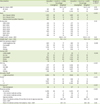2. Centers for Disease Control and Prevention (US). Healthy People 2020 Objectives for the Nation [Internet]. Atlanta (GA): Centers for Disease Control and Prevention;2016. cited 2017 August 26. Available from:
https://www.cdc.gov/breastfeeding/policy/hp2020.htm.
3. American Academy for Pediatrics. Section on Breastfeeding. Breastfeeding and the use of human milk. Pediatrics. 2012; 129:e827–e841.
4. Victora CG, Bahl R, Barros AJ, França GV, Horton S, Krasevec J, Murch S, Sankar MJ, Walker N, Rollins NC. Lancet Breastfeeding Series Group. Breastfeeding in the 21st century: epidemiology, mechanisms, and lifelong effect. Lancet. 2016; 387:475–490.

6. Shin DW, Nam S, Bang YS, Lee JY. Estimation of the prevalence of Korean adults aged 50 years or more with knee osteoarthritis based on the data from fifth Korea National Health and Nutrition Examination Survey. J Korean Med Assoc. 2013; 56:431–436.

8. Roman-Blas JA, Castañeda S, Largo R, Herrero-Beaumont G. Osteoarthritis associated with estrogen deficiency. Arthritis Res Ther. 2009; 11:241.

9. Srikanth VK, Fryer JL, Zhai G, Winzenberg TM, Hosmer D, Jones G. A meta-analysis of sex differences prevalence, incidence and severity of osteoarthritis. Osteoarthritis Cartilage. 2005; 13:769–781.

10. Battin DA, Marrs RP, Fleiss PM, Mishell DR Jr. Effect of suckling on serum prolactin, luteinizing hormone, follicle-stimulating hormone, and estradiol during prolonged lactation. Obstet Gynecol. 1985; 65:785–788.
11. Centers for Disease Control and Prevention (US). National Health and Nutrition Examination Survey. Questionnaires, datasets, and related documentation [Internet]. Atlanta (GA): Centers for Disease Control and Prevention;2015. cited 2017 August 1. Available from:
https://www.cdc.gov/nchs/nhanes/nhanes_questionnaires.htm.
12. Centers for Disease Control and Prevention (US). NCHS Research Ethics Review Board (ERB) Approval.[Internet]. Atlanta (GA): Centers for Disease Control and Prevention;2017. cited 2017 September 4. Available from:
https://www.cdc.gov/nchs/nhanes/irba98.htm.
13. Centers for Disease Control and Prevention (US). National Health and Nutrition Examination Survey: 2011??012 data documentation, codebook, and frequencies [Internet]. Atlanta (GA): Centers for Disease Control and Prevention;2013. cited 2017 August 1. Available from:
https://wwwn.cdc.gov/Nchs/Nhanes/2011-2012/MCQ_G.htm#MCQ195.
14. American Academy of Pediatrics, Work Group on Breastfeeding. Breastfeeding and the use of human milk. Pediatrics. 1997; 100:1035–1039.
15. Ushiyama T, Ueyama H, Inoue K, Ohkubo I, Hukuda S. Expression of genes for estrogen receptors alpha and beta in human articular chondrocytes. Osteoarthritis Cartilage. 1999; 7:560–566.

16. Braidman IP, Hainey L, Batra G, Selby PL, Saunders PT, Hoyland JA. Localization of estrogen receptor beta protein expression in adult human bone. J Bone Miner Res. 2001; 16:214–220.

17. Dietrich W, Haitel A, Holzer G, Huber JC, Kolbus A, Tschugguel W. Estrogen receptor-beta is the predominant estrogen receptor subtype in normal human synovia. J Soc Gynecol Investig. 2006; 13:512–517.

18. Sciore P, Frank CB, Hart DA. Identification of sex hormone receptors in human and rabbit ligaments of the knee by reverse transcription-polymerase chain reaction: evidence that receptors are present in tissue from both male and female subjects. J Orthop Res. 1998; 16:604–610.

19. Petrakis NL, Wrensch MR, Ernster VL, Miike R, Murai J, Simberg N, Siiteri PK. Influence of pregnancy and lactation on serum and breast fluid estrogen levels: implications for breast cancer risk. Int J Cancer. 1987; 40:587–591.







 PDF
PDF ePub
ePub Citation
Citation Print
Print


 XML Download
XML Download